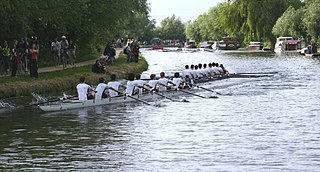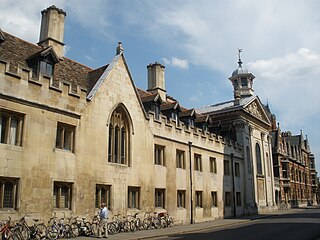
Trinity College is a constituent college of the University of Cambridge. Founded in 1546 by King Henry VIII, Trinity is one of the largest Cambridge colleges, with the largest financial endowment of any college at either Cambridge or Oxford. Trinity has some of the most distinctive architecture in Cambridge with its Great Court said to be the largest enclosed courtyard in Europe. Academically, Trinity performs exceptionally as measured by the Tompkins Table, coming top from 2011 to 2017. Trinity was the top-performing college for the 2020–21 undergraduate exams, obtaining the highest percentage of good honours.

Peterhouse is the oldest constituent college of the University of Cambridge in England, founded in 1284 by Hugh de Balsham, Bishop of Ely. Peterhouse has around 300 undergraduate and 175 graduate students, and 54 fellows. It is quite often erroneously referred to as Peterhouse College, although the correct name is simply Peterhouse.

Richard Porson was an English classical scholar. He was the discoverer of Porson's Law. The Greek typeface Porson was based on his handwriting.
The Vinerian Scholarship is a scholarship given to the University of Oxford student who "gives the best performance in the examination for the degree of Bachelor of Civil Law". Currently, £2,500 is given to the winner of the scholarship, with an additional £950 awarded at the examiners' discretion to a proxime accessit (runner-up).

A May Ball is a ball at the end of the academic year that takes place at any of the colleges of the University of Cambridge. They are elaborate and lavish formal affairs, requiring black tie or sometimes white tie, with ticket prices ranging from around £100 to as much as £640 for a pair of dining tickets at Trinity. May Ball budgets can exceed £100,000; a report by the student newspaper Varsity in 2016 found that the budget for the 2015 Trinity ball was £286,000. The balls are held in the colleges, starting around from 6-9 p.m. and lasting until well after dawn. "Survivors photographs" are taken of those who last until morning. Other colleges frequently hold winter balls, such as the popular Selwyn Snowball, who recently had acts such Tinchy Stryder and Mumford and Sons headlining.

The Ascension Parish Burial Ground, formerly known as the burial ground for the parish of St Giles and St Peter's, is a cemetery off Huntingdon Road in Cambridge, England. Many notable University of Cambridge academics are buried there, including three Nobel Prize winners.

The May Bumps are a set of rowing races, held annually on the River Cam in Cambridge, England. They began in 1887 after separating from the Lent Bumps, the equivalent bumping races held at the end of February or start of March. Prior to the separation there had been a single set of annual bumps dating from its inception in 1827. The races are open to all college boat clubs from the University of Cambridge, the University Medical and Veterinary Schools and the Anglia Ruskin Boat Club. The May Bumps takes place over four days in mid-June and is run as a bumps race.

Matthew Wren was an influential English clergyman, bishop and scholar.

Queen Elizabeth Grammar School (QEGS) is an independent, public school for boys in Wakefield, West Yorkshire, England. The school was founded by Royal Charter of Queen Elizabeth I in 1591 at the request of leading citizens in Wakefield 75 in total and some of whom formed the first governing body.
The Chancellor's Gold Medal is a prestigious annual award at Cambridge University for poetry, paralleling Oxford University's Newdigate Prize. It was first presented by Prince William Frederick, Duke of Gloucester and Edinburgh during his time as Chancellor of the University of Cambridge. In the mid 19th century, the topic for each year was sent out at the end of Michaelmas Term, with a requirement that entries were submitted by 31 March of the following year. A second requirement is and has been that poems must be submitted anonymously. Over the last few decades the system of set topics has been abandoned.
Retford Oaks Academy is a coeducational secondary school and sixth form located in the market town of Retford, Nottinghamshire, England, situated in the district of Bassetlaw.

Trumpington Street is a major historic street in central Cambridge, England. At the north end it continues as King's Parade where King's College is located. To the south it continues as Trumpington Road, an arterial route out of Cambridge, at the junction with Lensfield Road.
The Faculty of Economics is one of the constituent departments of the University of Cambridge. It is composed of five research groups, in macroeconomics, microeconomic theory, economic history, econometrics, and empirical microeconomics. It is located in the Sidgwick Site in Cambridge, has been host to many distinguished economists, and is regarded as the birthplace of macroeconomics. 19 students or members of the faculty have won the Nobel Memorial Prize in Economic Sciences.
The history of black people in Cambridge, UK cannot easily be separated from the history of Cambridge University. The university has attracted students from Africa and the African diaspora to the town of Cambridge for more than two centuries. Several notable black people had a Cambridge association in the eighteenth and nineteenth centuries, and at the end of the eighteenth century Cambridge became a centre of abolitionist sentiment. From the end of the nineteenth century the university started to admit black students in larger numbers. In recent decades, however, the relatively low number of black students admitted to the university has become a topic of media comment and public concern.
James Devereux Hustler (1784–1849) was an English cleric and academic. He was a mathematician, elected a Fellow of the Royal Society in 1819.








